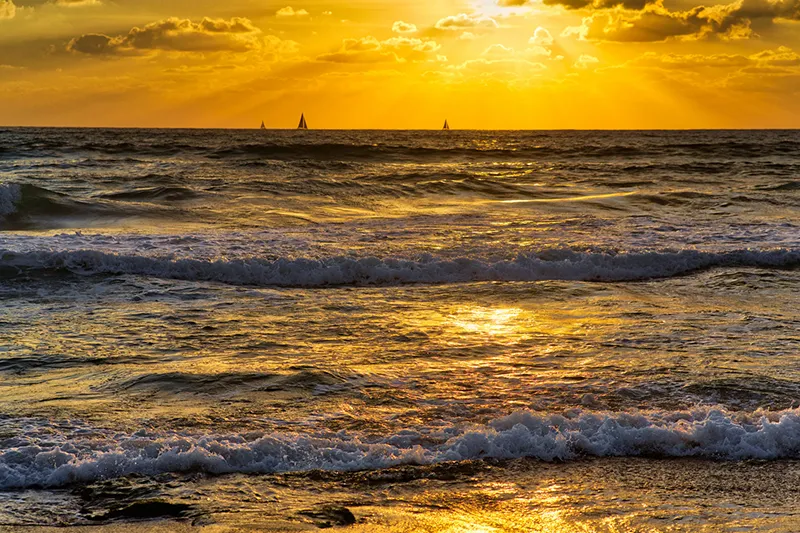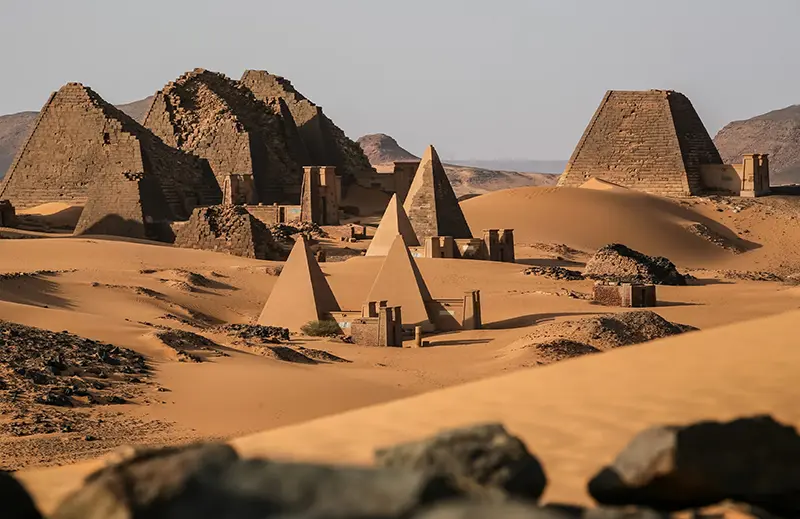The Mediterranean Sea is one of the largest inland seas on Earth. It lies between Europe, Africa and Asia, washing the shores of many countries and is connected to the Atlantic Ocean through the Strait of Gibraltar.
History
More than one great civilization has been borne by the Mediterranean. To this day, it remains the knot that connects Europe, Africa and the Middle East for centuries.
The living space of the sea itself and its coast is a vast, colorful and multifaceted world, equal to none on our planet. It can be explored endlessly.
The Mediterranean Sea can be without exaggeration called the cradle of humanity. On its shores the most powerful civilizations that ever existed on earth were born, on whose ruins the modern civilized world later grew. The ancient states of the Mediterranean basin serve as an inexhaustible treasure trove of historical examples and lessons for mankind.
It all began as far back as four thousand years B.C., when Mesopotamia, the oldest culture of the Indo-European civilization, appeared on the eastern coast of the Mediterranean Sea. Around the same period was the birth of the Egyptian culture. According to the results of excavations two thousand years later the first shoots of the Mycenaean civilization, considered one of the earliest stages of development of ancient Greece, began to appear.
But the Roman Empire reached the greatest heights in the development of the Mediterranean coast. It is no coincidence that the Romans began to call this sea Mare Nostrum – “Our Sea. This was not a manifestation of megalomania, but the Roman Empire did manage to control virtually the entire Mediterranean basin thanks to its victories in the Punic Wars. No one had the courage to take advantage of the situation, and pirate attacks were out of the question. It is also a testament to the limitless power of the Romans in the region that the Mediterranean Sea during the period of Roman domination is sometimes quite seriously referred to as the “Roman lake”. Something similar was repeated only by the Arab Caliphate in northern Africa on the Iberian Peninsula, but much later, in the seventh century. It was then that the main trade routes of Italian merchants, who grew rich by leaps and bounds, passed through the Mediterranean waters. Venetian merchants had special weight in those days – they could well call themselves masters of the Mediterranean Sea.
The history of the Mediterranean is also associated with many wars. Ancient city-states and powerful empires, individual countries and coalitions of powers fought each other. Since the Punic Wars between Rome and Carthage (from 364 to 146 B.C.), the battles in the Mediterranean Sea have proceeded with the same perennial rhythm as the situation in the adjacent land regions has changed. The main wars of the 20th century, World Wars I and II, also left their mark on the history of Mediterranean wars, although the main naval battles in both the former and the latter took place in the seas of the Atlantic and the Pacific. Each of the countries involved in these wars sought primarily control of the European and African coasts, as well as the strategically important straits of Gibraltar, the Bosphorus, and the Dardanelles.
As the Cold War (conventionally dated 1946-1991) unfolded, the Mediterranean militarized again. After World War II, the U.S. Sixth Fleet continued to be based in Italy. In 1949, after the creation of NATO, its naval forces also established themselves in the Mediterranean ports.
Geography
The Mediterranean is usually divided into three basins: in the west – the Algiers-Provence Basin, which in some areas may be deeper than 2,800 m; in the middle – the deeper Central Basin, which goes deeper by 5,000 m and more and includes the Central Basin of the Mediterranean Sea, and finally, the Eastern (Levantine) basin.
The Mediterranean is one of the largest seas on the planet: its area is 2,500,000 km2. It divides (and unites!) Europe, Africa and Asia. The shores of 22 countries are adjacent to it.
Flora and fauna
Experts may note that the populations of fish and mammal species here are not as numerous as, say, in the seas of the Pacific or the Indian Ocean. This is true, but the number of species nevertheless deserves the description “amazing”. There are about 550 species of fish, including about 70 endemics. The warm waters of the Mediterranean are home to many valuable commercial species such as tuna, mullet, mackerel and herring, and many, many other species. Mollusks – mussels, oysters, sea figs – are a special “specialty” of the Mediterranean Sea. From cephalopods – octopus, squid. Crustaceans of all kinds and sizes. There are also many species of jellyfish, but a large variety of phyto- and zooplankton, on the contrary, is not observed, respectively, few and large fish. There is only one species of seal. But there is a large population of dolphins – bottlenose dolphins, killer whales, there are other cetaceans and sea turtles. The bottom of the coastal strip is well heated, and there is no shortage of iridescent actinids, ascidians, echinoderms (sea urchins and sea stars). Some regions, especially the Aegean Sea, are home to tropical sponges and corals.
Resorts
Any mention of the Mediterranean Sea is associated primarily with a special quality of life. Its main distinguishing feature is the serene ease of being. Which is absolutely true when it comes to Mediterranean resorts, the exact number of which is not known, because even the smallest fishing village can give the tourist if not high comfort, then the enjoyment of the sea and the sun, healthy and fresh food – by all means. And if you remember that almost every bay of the coast, on every island, you will certainly find traces of ancient civilization, and in many regions – cities and fortresses of different eras, the time spent by the sea, will never go in vain. Even better, preparing for a trip to the Mediterranean Sea, to take the trouble to read something about the places where you intend to go, and not just guidebooks.
Among the resorts of the Mediterranean Sea is – how can they not be here – and its “grand”. Do you want to rest expensive and “cool”, among the famous people? – You are on the French Riviera Cote d’Azur and other Rivieras, in Sardinia. Are you for the reasonable expenses? – Turkey and Egypt are waiting for you, you can also find democratic resorts in Italy, Greece and Spain.
But someone is resting, and someone at the same time working The Mediterranean Sea plies countless number of oil tankers and ships with agricultural products, coming from the Middle East to Western Europe, and from there are delivered raw materials for industrial enterprises and high-tech finished products. Major Mediterranean ports are linked by pipeline to Western European countries and to oil fields in the Middle East and North Africa.
General Information
- The Intercontinental Sea of the Atlantic Ocean (separates Africa, Europe and Asia).
- Major basin seas: Adriatic Sea, Alboran Sea, Ionian Sea, Ligurian Sea, Tyrrhenian Sea, Aegean Sea.
- It has two straits and channels: the Dardanelles, which lead to the Sea of Marmara and through the Bosphorus to the Black Sea; the Gibraltar Channel, which leads to the Atlantic Ocean; the Suez Canal, which leads to the Red Sea and through it to the Indian and Pacific Oceans.
- Major islands: Balearic, Cyprus, Corsica Sardinia, Sicily, Crete.
- Major inflowing rivers: the Ebro, Rhone, Tiber, Po, Nile and others; their total annual flow is about 430 km3 .
- The largest ports are Marseilles and its outports (France), Genoa, Naples, Trieste (Italy), Barcelona (Spain), Piraeus (Greece), Alexandria (Egypt), As-Sidr (Libya).
- Currents: Canary, Levantine.
- Area: 2,500,000 km2.
- Water volume: 3,839,000 km3.
- Average depth: 1541 m.
- Maximum depth: 5121 m.
- Salinity: 36-39.5 %о.
Basin countries
- Europe: France, Italy, Greece, Spain, United Kingdom (Gibraltar Turkey, Slovenia, Monaco, Malta, Bosnia and Herzegovina, Croatia, Albania, Montenegro, Cyprus and the partially recognized Republic of Northern Cyprus.
- Africa: Libya, Egypt, Tunisia, Algeria, Morocco, Spain (Ceuta and Melilla).
- Asia: Israel, Syria, Lebanon, Turkey, Egypt.
Economics
- Transit of cargo ships (transportation of oil, industrial raw materials, agricultural products).
Fishing. - Services: tourism, including sea cruises.
Climate and weather
- Average temperature of summer: +22 – +30ºС.
- Average temperature in winter: +10 – +14°C.
- Average temperature of water in summer: +19 – +30°C.
- Average water temperature in winter: +8 to +17°C.
- Average rainfall: 100-1300 mm (from south-east to north-west).
- Relative humidity varies from 50-65% in summer to 65-80% in winter.
Fun facts
- In 2010, an article appeared in the American journal Nature, based on the most recent geological data on the Mediterranean Sea. Entered into the computer, they allowed to simulate the situation that occurred 5.3 million years ago. For 300,000 years before that, tectonic processes separated the Mediterranean Sea from the Atlantic and Indian Oceans, and it dried up. But erosion and seismic activity has created an isthmus 200 km long, 6 km wide and about 300 m deep in the area of Gibraltar today, through which the water rapidly flooded a huge basin, it was an incredible flood – the water was arriving at 100 million m3 per second, so that the sea level rose to 10 m per day. The Mediterranean Sea filled with water in just two years.
- In the 1920s, the German architect Hermann Sörgel unveiled his plan, which he called “Atlantropa. He proposed damming the Straits of Gibraltar and the Dardanelles to provide elevation differences for hydroelectric power, which could not only solve the electricity shortage, but also provide desalinated water to the Sahara. “Atlantropa” fortunately remained only on paper, not a project, but a blueprint – the consequences of such interference with nature could have been too catastrophic.
- The Mediterranean diet has an excellent reputation: fish, cold-pressed olive oil, lots of greens, vegetables, a moderate amount of sweet fruit, cheese, rejection of red meat and eggs. Medical studies have long proved that such a diet not only helps to maintain slimness, lightness and mobility, but also keeps away from atherosclerosis and hypertension.
- The most famous of the volcanoes of the Mediterranean Sea are Vesuvius near Naples and Etna in Sicily. But the most volcanically active region is the Tyrrhenian Sea and its islands, especially Ischia. Another volcanic island site is the Santorini Archipelago in the Aegean Sea.
- A recent publication of the scientific publication PLoS ONE (The Public Library of Science), which contains the results of observations of scientists from many countries around the world on the flora and fauna of the Mediterranean Sea in the last 80 years, caused a great resonance in the world. They make the conclusion unambiguous: the sea is on the verge of ecological disaster. The main reasons are threefold. The first is climate change of the planet. The second is the excessive amount of fish caught.
And the third is the penetration to the Mediterranean of such species of marine flora and fauna, which threaten to displace its native inhabitants. So far, 4% of such species, and half of them have entered through the Suez Canal. Man has no moral right to turn a blind eye to environmental problems, but also to panic. Scientists continue their monitoring with a practical purpose – to formulate effective measures to save the Mediterranean Sea. In the meantime, in 2010, the quota for bluefin tuna fishing in the eastern Atlantic and the Mediterranean Sea was reduced by 40% compared to 2009.




